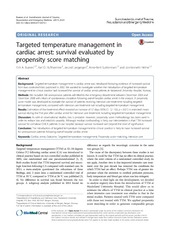Targeted temperature management in cardiac arrest: survival evaluated by propensity score matching
| dc.contributor.author | Buanes, Eirik Alnes | en_US |
| dc.contributor.author | Hufthammer, Karl O. | en_US |
| dc.contributor.author | Langørgen, Jørund | en_US |
| dc.contributor.author | Guttormsen, Anne-Berit | en_US |
| dc.contributor.author | Heltne, Jon-Kenneth | en_US |
| dc.date.accessioned | 2017-09-08T12:49:22Z | |
| dc.date.available | 2017-09-08T12:49:22Z | |
| dc.date.issued | 2017 | |
| dc.identifier.issn | 1757-7241 | |
| dc.identifier.uri | https://hdl.handle.net/1956/16621 | |
| dc.description.abstract | Background: Targeted temperature management in cardiac arrest was introduced following evidence of increased survival from two controlled trials published in 2002. We wanted to investigate whether the introduction of targeted temperature management to clinical practice had increased the survival of cardiac arrest patients at Haukeland University Hospital, Norway. Methods: We included 336 unresponsive patients admitted to the emergency department between December 2003 and December 2008 with return of spontaneous circulation following out-of-hospital cardiac arrest in the analysis. A propensity score model was developed to evaluate the survival of patients receiving intensive care treatment including targeted temperature management, compared with intensive care treatment not including targeted temperature management. Results: Estimation of the treatment effect revealed an increase of 57 days (95% CI: 12–103, p = 0.01) in restricted mean survival during the first year after cardiac arrest for intensive care treatment including targeted temperature management. Discussion: As with all observational studies, bias is probable. However, propensity score methodology has been used in order to reduce bias and establish causality. Although residual confounding is likely, our interpretation is that TTM increased survival for comatose OHCA patients in our hospital because survival increased well beyond the level of significance. Conclusion: The introduction of targeted temperature management to clinical practice is likely to have increased survival for unresponsive patients following out-of-hospital cardiac arrest. | en_US |
| dc.language.iso | eng | eng |
| dc.publisher | BioMed Central | eng |
| dc.relation.ispartof | <a href="http://hdl.handle.net/1956/16620" target="blank">Cardiac Arrest in a Community: Epidemiology, Treatment, and Outcome</a> | |
| dc.rights | This article is distributed under the terms of the Creative Commons Attribution 4.0 International License (http://creativecommons.org/licenses/by/4.0/), which permits unrestricted use, distribution, and reproduction in any medium, provided you give appropriate credit to the original author(s) and the source, provide a link to the Creative Commons license, and indicate if changes were made. The Creative Commons Public Domain Dedication waiver (http://creativecommons.org/publicdomain/zero/1.0/) applies to the data made available in this article, unless otherwise stated. | eng |
| dc.rights.uri | https://creativecommons.org/licenses/by/4.0/ | eng |
| dc.subject | Cardiac arrest | eng |
| dc.subject | Outcome | eng |
| dc.subject | Targeted temperature management | eng |
| dc.subject | Propensity score matching | eng |
| dc.subject | Intensive care | eng |
| dc.title | Targeted temperature management in cardiac arrest: survival evaluated by propensity score matching | en_US |
| dc.type | Peer reviewed | |
| dc.type | Journal article | |
| dc.description.version | publishedVersion | en_US |
| dc.rights.holder | Copyright The Author(s) | |
| dc.identifier.doi | https://doi.org/10.1186/s13049-017-0373-1 | |
| dc.source.journal | Scandinavian Journal of Trauma, Resuscitation and Emergency Medicine | |
| dc.source.40 | 25 | |
| dc.source.14 | 31 | |
| dc.subject.nsi | VDP::Medisinske Fag: 700 | en_US |
Tilhørende fil(er)
Denne innførselen finnes i følgende samling(er)
Med mindre annet er angitt, så er denne innførselen lisensiert som This article is distributed under the terms of the Creative Commons Attribution 4.0 International License (http://creativecommons.org/licenses/by/4.0/), which permits unrestricted use, distribution, and reproduction in any medium, provided you give appropriate credit to the original author(s) and the source, provide a link to the Creative Commons license, and indicate if changes were made. The Creative Commons Public Domain Dedication waiver (http://creativecommons.org/publicdomain/zero/1.0/) applies to the data made available in this article, unless otherwise stated.

